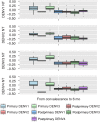Dengue Virus (DENV) Neutralizing Antibody Kinetics in Children After Symptomatic Primary and Postprimary DENV Infection
- PMID: 26704615
- PMCID: PMC4813744
- DOI: 10.1093/infdis/jiv759
Dengue Virus (DENV) Neutralizing Antibody Kinetics in Children After Symptomatic Primary and Postprimary DENV Infection
Abstract
The immune response to dengue virus (DENV) infection is complex and not fully understood. Using longitudinal data from 181 children with dengue in Thailand who were followed for up to 3 years, we describe neutralizing antibody kinetics following symptomatic DENV infection. We observed that antibody titers varied by serotype, homotypic vs heterotypic responses, and primary versus postprimary infections. The rates of change in antibody titers over time varied between primary and postprimary responses. For primary infections, titers increased from convalescence to 6 months. By comparing homotypic and heterotypic antibody titers, we saw an increase in type specificity from convalescence to 6 months for primary DENV3 infections but not primary DENV1 infections. In postprimary cases, there was a decrease in titers from convalescence up until 6 months after infection. Beginning 1 year after both primary and postprimary infections, there was evidence of increasing antibody titers, with greater increases in children with lower titers, suggesting that antibody titers were boosted due to infection and that higher levels of neutralizing antibody may be more likely to confer a sterilizing immune response. These findings may help to model virus transmission dynamics and provide baseline data to support the development of vaccines and therapeutics.
Keywords: dengue; longitudinal antibody kinetics; neutralizing antibody; vaccine.
© The Author 2015. Published by Oxford University Press for the Infectious Diseases Society of America. All rights reserved. For permissions, e-mail journals.permissions@oup.com.
Figures



References
Publication types
MeSH terms
Substances
Grants and funding
LinkOut - more resources
Full Text Sources
Other Literature Sources
Medical

